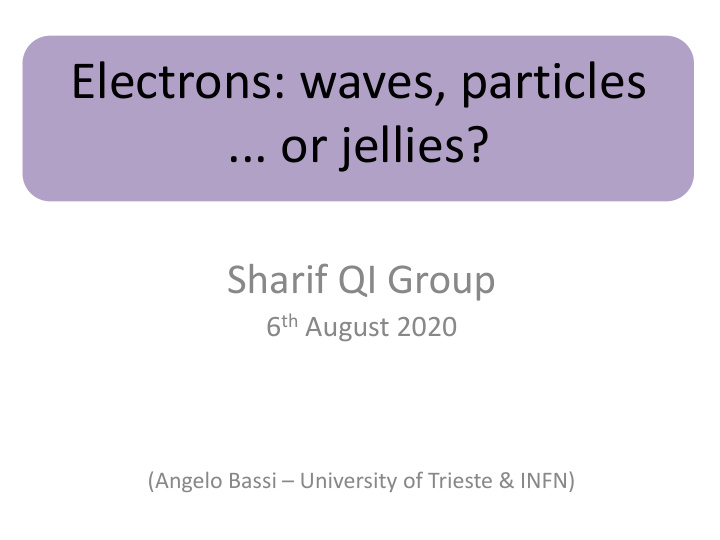



Electrons: waves, particles ... or jellies? Sharif QI Group 6 th August 2020 (Angelo Bassi – University of Trieste & INFN)
“The trouble with quantum mechanics” I think I can Quantum safely say that mechanics is no one certainly understands imposing. But an quantum inner voice tells mechanics me that it is not Richard yet the real thing. Feynman Albert Einstein if you push quantum I’m not as sure mechanics hard as I once was enough it will break about the down and something future of else will take over – quantum something we can’t mechanics. envisage at the Steven moment. Weinberg Anthony J. Leggett
Quantum superpositions The Schrödinger equation is linear Wave function: |here> + |there> (to be normalized) What does it mean?
Option A: particle |here> + |there> means that a particle is either here or there ; we are simply ignorant about its precise location. The wave function is there to reflect our ignorance. This is the simplest explanation, which eventually leads to Bohmian Mechanics. But one has to accept two things: • Quantum Mechanics is incomplete , the wave function is not everything. • The wave function cannot simply reflect our ignorance , otherwise one cannot explain the double slit experiment.
Double slit experiment This is what classical particles do: This is what quantum particles do: the wavefunction “guides” them Bohmian Mechanics takes care of all these things.
Option B: wave |here> + |there> means that the particle is here and there , like for any wave. This is a more challenging explanation, which eventually leads to collapse models (I deliberately ignore Many Worlds). But one has to accept two things: • Particles are not particles, they are not localized. They are waves. • Upon measurements, particles are always well localized, never split in two (or more), like waves.
Option C: none |here> + |there> means that the particle is neither here or there… In a sense, this is the official solution. Only in a sense... The official position is the wave function is not about the state of the particle, but about the outcomes of measurements: The square modulus of the wave function gives the probability that, in a position measurement, the particle is found to be here or there
Standard Quantum Mechanics Quantum world Classical world The wave function gives the probabilities of outcomes of measurements
The cat… Quantum world Classical world The wave function gives the probabilities of outcomes of measurements ??? ?
The Problem with Quantum Mechanics Quantum world Classical world The wave function gives the probabilities of outcomes of measurements The Copenhagen interpretation assumes a mysterious division between the microscopic world governed by quantum mechanics and a macroscopic world of apparatus and observers that obeys classical physics. […] S. Weinberg, Phys. Rev. A 85, 062116 (2012)
Solutions
Bohmian Mechanics The cat is always either here or there. The wave function is there to guide the cat.
Collapse models The wave function does describe the state of the system*. Microscopic systems are quantum (linearity), macroscopic systems are not (breakdown of linearity). This is implemented by modifying the Schrödinger equation. The new dynamics is nonlinear and describes the quantum micro- world, the classical macro-world, as well as the transition from one to the other. Wave Particle Unified dynamics for microscopic and macroscopic systems (title of the original GRW paper)
<latexit sha1_base64="UmVlvdtczNBO6x7ieCo/R+bWR34=">ACSHicdVA9TxtBEN0zEIghwYEyzQorEpV1FyEldAiaFBQgYUDyOtbcMrZH3O2duf40Nl/jJ/AP6BAoUqXZQue8YFn696em9Gb+bFeUKOw/AmqM3Mzn2YX/hYX1z69Hm58WXl0GWF1djWZLZ4xgcJmSwzcQJHucWIY0TPIpPdyr/6Ayto8wc8GWO3RQGhvqkgb3UaxyMVO5IWTCDBJWlwZDB2uxc9S3oUg2By91x7+I3PZ0bl2ok3/GkGo17jWbYCieQr0k0JU0xV6vcatOMl2kaFgn4FwnCnPulmCZtI+rq8JhDvoUBtjx1ECKrltOvh/Lb4UDzmSOVlIiJyI+3Sghde4yjf1kCjx0L71KfMvrFNz/2S3J5AWj0VUQk3+wCnLakq8V5QlZIbqcpRkpAYLzGhJgtZeLHzPd9H9PL71+TweyvaG3ubzS3tqfNLIivYk2si0j8EFvil9gTbaHFlbgT9+IhuA7+BH+Df4+jtWC6syqeoVb7D5b1teM=</latexit> <latexit sha1_base64="NX0NDfYPMpG9VtQkFRhM8dgA5xs=">ACE3icbVC7TsNAEDzDOEVoKTgRIREFdkoEtBF0FBQBIkAUhyi9WUTpzP1t0aETkp+QS+ghYqOkTLB1DwL9ghBa+pRjO72p0JYiUtue67MzE5NT0zW5grzi8sLi2XVlbPbJQYgQ0RqchcBGBRSY0NkqTwIjYIYaDwPLg+zP3zGzRWRvqU+jG2Quhp2ZUCKJPapQ1/wP0roPR42L69lAM/tI3oHsKuT+43GmXym7FHYH/Jd6YlNkY9Xbpw+9EIglRk1BgbdNzY2qlYEgKhcOin1iMQVxD5sZ1RCibaWjIEO+lVigiMdouFR8JOL3jRCa/thkE2GQFf2t5eL/3nNhLp7rVTqOCHUIj9EMkuYH7LCyKwh5B1pkAjyz5FLzQUYIEIjOQiRiUlWTHrw/ud/i8526l41cr+SbVcOxg3U2DrbJNtM4/tsho7YnXWYILdsQf2yJ6ce+fZeXFev0YnPHOGvsB5+0T+pyeZg=</latexit> <latexit sha1_base64="ynokHlSRT2HusiGv6ILBnME7SY=">ACUXicbVC7bhNBFB0vr+DwMFDSjLCQnCLWrEFJEi0qSgCBJOInXq7uTa/sqsw9m7kaJRvN1fAIVBR+QFio61msXkHCrM+cxd+ZklSbLYfi9E9y5e+/+g62H3e1Hj587T17fmzL2icqFKX5jQDi5oKnDCxtPKIOSZxpPs/GCln1ygsVQWn/mqwiSHRUFzUsANlfaSeAnsPvr0ckZ7scY5D+K5AeUi7+KpEkPZiMfG1oseWfm1tob78be48ztrs+D9pIvPqXdy53G7kbrmE97/XAYtiNvg2gD+mIzR2nvR3xWqjrHgpUGa6dRWHiwDApjb4b1xYrUOewGkDC8jRJq6twcvXtQUuZYVGkpYtiX8nHOTWXuVZ48yBl/amtiL/p01rnr9LHBVzVio1SImje0iqw1/aI8I4PMsHo5SiqkAgPMaEiCUg1ZN4V3mz6im7+/DY5Hw2g8fP9p3N/sGlmS7wUr8RAROKt2BeH4khMhBJfxbX4KX51vnV+ByI1tags8m8EP9MsP0HvXK1GA=</latexit> The GRW model Systems are described by the wave function. This evolves according to the Schrödinger equation, except that at random times (with frequency λ) they undergo spontaneous collapses: ✓ 1 ◆ 3 ˆ qi − x )2 L i x | ψ i − (ˆ 4 L i ˆ 2 r 2 | ψ i ! x = e C k ˆ π r 2 L i x | ψ ik C The probability (density) for a collapse to occur around x is given by k ˆ L i x | ψ ik 2 è Collapses are random in space and time è Two parameters defining the model: λ and r C
<latexit sha1_base64="0l9jnCOc8qGTxL9LEnUZE9Pvj4Y=">ACMnicdVC7TsNAEDyHd3gFKGlOREhUkY2QgAZF0FBQBIkEpNhY62MTrHP1t0agZz8DZ/AV9BCAxIFouUjsEMKnlONZna1OxMkoTRk209WaWx8YnJqeqY8Oze/sFhZWm6ZONUCmyIOY30WgMFQKmySpBDPEo0QBSGeBr2Dwj+9Qm1krE7oJkEvgq6SHSmAcsmv7LkdDSJzL4Gyo4F/fS7bmKkq0F1Qxkbp/43G3Pyj7lapds4fgv4kzIlU2QsOvLgXsUgjVCRCMKbt2Al5GWiSIr9XdlODCYgedLGdUwURGi8b5hzw9dQAxTxBzWXIhyJ+3cgMuYmCvLJCOjS/PQK8S+vnVJnx8ukSlJCJYpDJPOExSEjtMwLRH4hNRJB8TlyqbgADUSoJQchcjHNGy36cH6m/01amzVnq7Z7vFWt74+amWarbI1tMIdtszo7ZA3WZILdsnv2wB6tO+vZerXePkdL1mhnhX2D9f4B0qSscg=</latexit> <latexit sha1_base64="TfCWstXNMkUkKfMv5sLsJpiWX0w=">AB/3icbVA9TwJBEN3DL8Qv1NJmIzGxIneGRO2INpaYyEcCFzK3DLhb+/cnTMhSOGvsNXKztj6Uyz8L94hYKvenlvJvPmBbGSlz308ktLa+sruXCxubW9s7xd29ho0SI7AuIhWZVgAWldRYJ0kKW7FBCAOFzWB4mfnNezRWRvqGRjH6IQy07EsBlEr+Qye2smNADxQWusWSW3an4IvEm5ESm6HWLX51epFIQtQkFjb9tyY/DEYkLhpNBJLMYghjDAdko1hGj98T0hB8lFijiMRouFZ+K+HtjDKG1ozBIJ0OgWzvZeJ/Xjuh/pk/ljpOCLXIDpFUOD1khZFpG8h70iARZMmRS80FGCBCIzkIkYpJWk/Whzf/SJpnJS9Svn8ulKqXsyaybMDdsiOmcdOWZVdsRqrM8Hu2BN7Zi/Oo/PqvDnvP6M5Z7az/7A+fgGfAOWkA=</latexit> The jump Initial Jump operator ˆ L i | ψ i wavefunction x x Jump probability ˆ L i x | ψ i Final k ˆ wavefunction L i x | ψ ik
<latexit sha1_base64="0l9jnCOc8qGTxL9LEnUZE9Pvj4Y=">ACMnicdVC7TsNAEDyHd3gFKGlOREhUkY2QgAZF0FBQBIkEpNhY62MTrHP1t0agZz8DZ/AV9BCAxIFouUjsEMKnlONZna1OxMkoTRk209WaWx8YnJqeqY8Oze/sFhZWm6ZONUCmyIOY30WgMFQKmySpBDPEo0QBSGeBr2Dwj+9Qm1krE7oJkEvgq6SHSmAcsmv7LkdDSJzL4Gyo4F/fS7bmKkq0F1Qxkbp/43G3Pyj7lapds4fgv4kzIlU2QsOvLgXsUgjVCRCMKbt2Al5GWiSIr9XdlODCYgedLGdUwURGi8b5hzw9dQAxTxBzWXIhyJ+3cgMuYmCvLJCOjS/PQK8S+vnVJnx8ukSlJCJYpDJPOExSEjtMwLRH4hNRJB8TlyqbgADUSoJQchcjHNGy36cH6m/01amzVnq7Z7vFWt74+amWarbI1tMIdtszo7ZA3WZILdsnv2wB6tO+vZerXePkdL1mhnhX2D9f4B0qSscg=</latexit> <latexit sha1_base64="TfCWstXNMkUkKfMv5sLsJpiWX0w=">AB/3icbVA9TwJBEN3DL8Qv1NJmIzGxIneGRO2INpaYyEcCFzK3DLhb+/cnTMhSOGvsNXKztj6Uyz8L94hYKvenlvJvPmBbGSlz308ktLa+sruXCxubW9s7xd29ho0SI7AuIhWZVgAWldRYJ0kKW7FBCAOFzWB4mfnNezRWRvqGRjH6IQy07EsBlEr+Qye2smNADxQWusWSW3an4IvEm5ESm6HWLX51epFIQtQkFjb9tyY/DEYkLhpNBJLMYghjDAdko1hGj98T0hB8lFijiMRouFZ+K+HtjDKG1ozBIJ0OgWzvZeJ/Xjuh/pk/ljpOCLXIDpFUOD1khZFpG8h70iARZMmRS80FGCBCIzkIkYpJWk/Whzf/SJpnJS9Svn8ulKqXsyaybMDdsiOmcdOWZVdsRqrM8Hu2BN7Zi/Oo/PqvDnvP6M5Z7az/7A+fgGfAOWkA=</latexit> Example: “large” superposition Jump operator ˆ L i x Initial | ψ i wavefunction d >> r C + Jump probability = 1/2 ˆ L i x | ψ i Final k ˆ wavefunction L i x | ψ ik
<latexit sha1_base64="0l9jnCOc8qGTxL9LEnUZE9Pvj4Y=">ACMnicdVC7TsNAEDyHd3gFKGlOREhUkY2QgAZF0FBQBIkEpNhY62MTrHP1t0agZz8DZ/AV9BCAxIFouUjsEMKnlONZna1OxMkoTRk209WaWx8YnJqeqY8Oze/sFhZWm6ZONUCmyIOY30WgMFQKmySpBDPEo0QBSGeBr2Dwj+9Qm1krE7oJkEvgq6SHSmAcsmv7LkdDSJzL4Gyo4F/fS7bmKkq0F1Qxkbp/43G3Pyj7lapds4fgv4kzIlU2QsOvLgXsUgjVCRCMKbt2Al5GWiSIr9XdlODCYgedLGdUwURGi8b5hzw9dQAxTxBzWXIhyJ+3cgMuYmCvLJCOjS/PQK8S+vnVJnx8ukSlJCJYpDJPOExSEjtMwLRH4hNRJB8TlyqbgADUSoJQchcjHNGy36cH6m/01amzVnq7Z7vFWt74+amWarbI1tMIdtszo7ZA3WZILdsnv2wB6tO+vZerXePkdL1mhnhX2D9f4B0qSscg=</latexit> <latexit sha1_base64="TfCWstXNMkUkKfMv5sLsJpiWX0w=">AB/3icbVA9TwJBEN3DL8Qv1NJmIzGxIneGRO2INpaYyEcCFzK3DLhb+/cnTMhSOGvsNXKztj6Uyz8L94hYKvenlvJvPmBbGSlz308ktLa+sruXCxubW9s7xd29ho0SI7AuIhWZVgAWldRYJ0kKW7FBCAOFzWB4mfnNezRWRvqGRjH6IQy07EsBlEr+Qye2smNADxQWusWSW3an4IvEm5ESm6HWLX51epFIQtQkFjb9tyY/DEYkLhpNBJLMYghjDAdko1hGj98T0hB8lFijiMRouFZ+K+HtjDKG1ozBIJ0OgWzvZeJ/Xjuh/pk/ljpOCLXIDpFUOD1khZFpG8h70iARZMmRS80FGCBCIzkIkYpJWk/Whzf/SJpnJS9Svn8ulKqXsyaybMDdsiOmcdOWZVdsRqrM8Hu2BN7Zi/Oo/PqvDnvP6M5Z7az/7A+fgGfAOWkA=</latexit> Example: “small” superposition Jump operator ˆ L i x Initial d << r C | ψ i wavefunction + + ˆ L i x | ψ i Final k ˆ wavefunction L i x | ψ ik
Recommend
More recommend